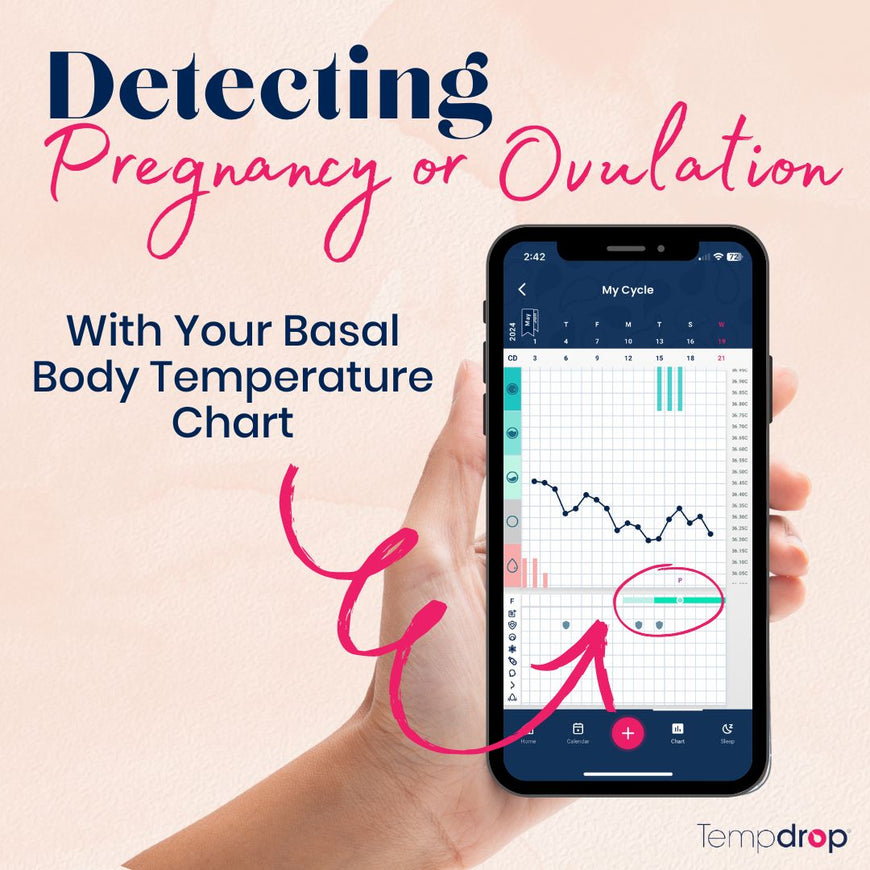Written by the Tempdrop Team
What is a Basal Body Temperature Chart
Detecting pregnancy or ovulation (to achieve pregnancy) is likely the reason you started tracking your basal body temperature (BBT) in the first place. Am I right?
If you're trying to conceive then your BBT charts will give you the data you need to detect ovulation and pregnancy. We'll show you how to identify a pregnancy basal body temperature chart.
How? Before we dive into how we detect ovulation and pregnancy let's start by understanding the basics of how to track your BBT and why it's so important. This will give you the necessary foundation to understand your personal charts.
The Basics of Charting
Body temperature is influenced by the cyclic ebb and flow of hormones in women. While men have a relatively static BBT, women see a noticeable difference in the pattern of their temps before and after ovulation.
In order to get a clear understanding of when you're ovulating or pregnant, you will need to track your BBT daily. You might also consider charting cervical mucus.

You can use a regular BBT thermometer (not to be confused with a fever thermometer) to catch a resting temperature as you wake early each morning. This traditional way of temping means you need to get up at the same time every day (usually between 5 and 7 am), follow strict rules about what you can/can’t do before taking your temperature, and deal with disturbances. Or you could buy a Tempdrop! Using a wearable fertility tracker like Tempdrop will make identifying your most accurate BBT seamless!
You will need to make a note of your daily temperature on your chart. You can use a printable paper-pencil chart or you can use Tempdrop's integrated charting app (or another charting app of your choice).
Once you have a few months worth of data to review you will begin to notice patterns and trends. This information will ultimately help you understand your ovulation time and help you detect pregnancy.
Why is it important?
In the book, The Fifth Vital Sign, Fertility Awareness Educator Lisa Hendrickson-Jack affirms that "your menstrual cycle is a vital sign, just like your pulse, temperature, respiration rate, and blood pressure." That's because your menstrual cycle can tell you a lot about your overall health.
One of the unbiased fertility signs you can track is your basal body temperature (BBT). By taking note of your BBT and observing trends throughout the menstrual cycle you can:
- Track ovulation
- Detect pregnancy
- Avoid pregnancy
- Recognize and troubleshoot hormonal and other issues
Now that we understand the basics and why its important we can begin exploring how to detect ovulation when using your BBT chart.
Detecting Ovulation Using Your Basal Body Temperature Chart
So how can you detect ovulation using BBT? Unfortunately, BBT alone doesn't predict ovulation but you can confirm that it has happened! If you decide to also track cervical mucus you can identify when your fertile window opens, in real-time.
Once you have 2 or more months of charts to review, predicting ovulation for your next cycle will become easier because you'll begin to notice which day of your cycle is your ovulation day based on your thermal shift.
Thermal Shift Patterns
When glancing at your BBT chart you will see a spike in temperature 1-2 days after ovulation. This is an indicator of your bodies thermal shift from the time before ovulation happens to the post-ovulation phase.

The most common pattern is the standard thermal shift. This is the one we will discuss in this article. The standard thermal shift is when you notice a series of low temps and then an obvious "shift" of at least two-tenths of a degree, indicating ovulation has happened. Your temperatures will remain at a higher level until the end of that cycle, when your temperatures will dip again and you will get your period (unless of course you are pregnant which we'll talk more about next).
If you are trying to conceive you'll want to consider having intercourse 2 or 3 days before you ovulate. Once you identify ovulation the two-week wait.
How to Detect Pregnancy Using Your BBT Chart

What to Remember
Here's the quick guide to detecting pregnancy or ovulation on your basal body temperature chart:
1. From the time of your period to ovulation your temps will be in a lower range.
2. Mid-cycle (might be later if you have irregular cycles) you’ll notice a rise in your basal body temperature.
3. Your temps will stay high until they drop again. (Once your temps rise up for at least 3 days and stay elevated, you'll know you've ovulated).
4. If your temps stay elevated beyond 18 days after ovulation then it's highly likely you are pregnant. This is your pregnancy basal body temperature chart.
For more information about hormonal health, tracking your fertility or preparing for a pregnancy visit our blog page.
References:
| Weschler, T. (2015). Taking Charge of Your Fertility (20th Anniversary ed.). New York, NY: HarperCollins. |

